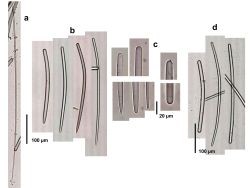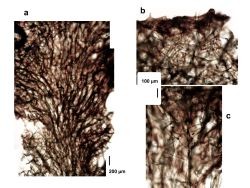orange
bushy
lobate
tube
soft
tough
Bahamas
Axinella morchella
Description: Erect bushes, usually with a narrow base. Individuals living in deep reef walls are made of irregular tubes arising from one another. Size may reach 50 or more cm in height and 5-10 cm in width. Sometimes there are massive individuals, wider than taller. The surface is strongly corrugated to lamellate, with hispid ridges aligned predominantly upwards, but often or in parts becoming irregularly honeycombed. The pinacoderm is rather lustrous stretched in between ridges. Oscules are scattered or at the end of tubular projections, usually with an organic, non-transparent collar. Color bright orange to orange-yellow. Consistency toughly compressible, but the tissue is easily squeezed out when handled. Skeleton as plumose spongin-enforced spicule tracts, 1-5 spicules thick, which ascend and diverge radially from the center; they are interconnected by clean sponge bridges or single spicules, forming a vertically elongated reticulation of 50-80 µm wide fibers with 40-150 µm wide meshes, which become more rectangular to square towards the surface. The peripheral skeleton is more dense and confused, with spongin only binding spicule ends. At the surface, erect spicules support a thick, organic pinacoderm 50-300 µm thick. Spicules are curved styles in two size categories, often strongly pithed by a middle canal. Styles I, thin to stout, 230-420 µm long by 2.5 to 15 µm wide, with smooth heads and short, acute, to mammiform, to blunt tips; a few of these blunt ends become almost to totally round, appearing as strongyles. Styles II, long and slender, scarce, 520-650 µm long by 4-8 µm wide. One specimen had a few oxea in two size categories, one of about the same size of the styles I (280-350 by 4-12.5 µm), as if they were modifications, and another very similar to those of other Axinella, with slightly asymmetric ends, larger than the styles I (480-490 by 10-12.5 µm); it could not be ascertained whether these were contamination or variably present.
Notes: This is usually a deep reef species, living both in exposed horizontal or inclined substratum, as well as in vertical or overhanging deep reef walls. This species was originally described under genus Teichaxinella de Laubenfels, 1936. It was synonymized to Axinella corrugata (George & Wilson, 1919), also pictured here, by Alvarez et al., (1998), but upon closer comparison of co-existing specimens in the Bahamas, we consider them different and decided to maintain A. morchella as a good species. A. corrugata has a less lustrous surface, with usually smoother lamellar ridges, and always has slightly asymmetric oxea in addition to the two categories of styles; its skeleton has less spongin. When found together, they are clearly different in aspect and texture. Because of the synonymy, material of A. morchella has probably been collected instead of the real A. corrugata for several natural product chemistry studies (e.g., Wilson et al., 1999) and their biotechnological production (e.g., Duckworth et al., 2003) involving this species. Indeed, this may be the case for material of A. corrugata from the molecular systematics studies of Gazave et al. (2010) and Morrow et al. (2012) (also included in Redmond et al., 2013). These studies found that A. corrugata and other species of the genus Axinella are not closely related to the type species of the genus Axinella, A. polypoides (Schmidt, 1862). In fact, the most recent 18S Ribosomal DNA phylogenetic tree (Redmond et al., 2013, fig. 12) shows the samples of Axinella corrugata falling in two distinct clades. One clade contains the samples from Bocas del Toro, Panama, and the other contains a sample from the Bahamas and a sample from the Florida Keys (and another of unknown origin; see Redmond et al., 2013, file 019 of the supplemental material). As it appears that A. morchella does not occur in Bocas del Toro and the Southern Caribbean (pers. obs. S.Z.), the samples from this locality are probably the real A. corrugata; the material from the other clade could thus belong to A. morchella. At any rate, the vouchers of the above-mentioned molecular analyses need to be reexamined to determine their real identity. The generic placement of this species also needs to be reassessed in light of the clade within which it falls. We thus maintain Axinella while the generic issue is clarified.
Stylissa caribica Lehnert & van Soest, 1998 is very probably a junior synonym of A. morchella. The body characteristics, skeleton and spicules, as well as the photo presented in the original description match our material. Comparisons of types would be needed to confirm this. We used this name in earlier versions of this catalogue.
Author Reference: (Wiedenmayer, 1977)
Link: World Porifera Database

![<i>Axinella morchella</i> <br />[Bahamas, Little San Salvador]](mini/00121/00718.jpg)
![<i>Axinella morchella</i> <br />[Bahamas, Little San Salvador]](mini/00121/00731.jpg)

